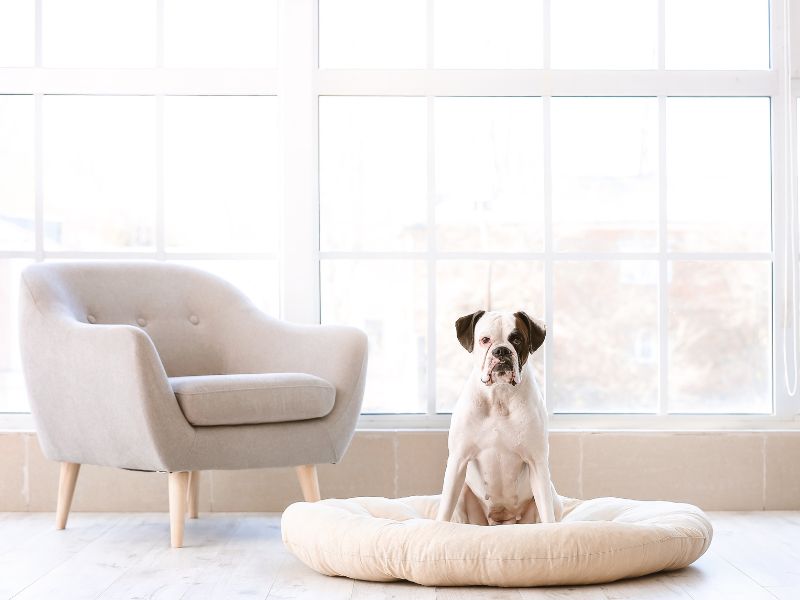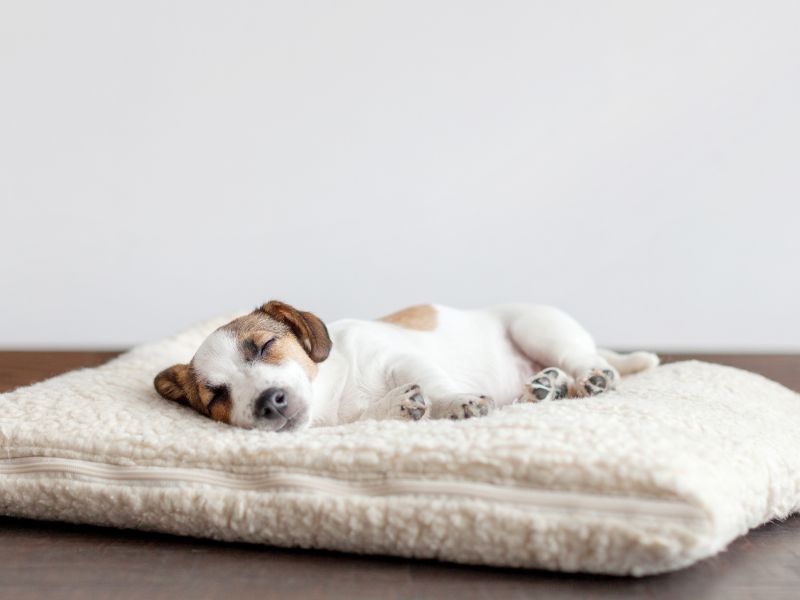Are you tired of searching for the perfect dog bed that matches your furry friend’s unique style and personality? Look no further! In this guide, we will show you how to make your own custom dog bed that not only provides comfort and support but also complements your home décor. Whether your dog prefers a plush and cozy retreat or a sleek and modern design, we’ve got you covered. With just a few simple steps and some basic materials, you can create a one-of-a-kind bed that your dog will love. Not only will this project save you money, but it will also give you the satisfaction of knowing that you’ve created something special for your beloved pet. So, grab your crafting tools and get ready to embark on a fun and rewarding DIY adventure that will leave tails wagging!
Why a Custom Dog Bed?
When it comes to your furry friend’s comfort, a custom dog bed offers several advantages over store-bought options. First and foremost, a custom bed allows you to tailor the design to suit your dog’s specific needs and preferences. Whether your dog has arthritis and requires extra support or simply prefers a certain type of fabric, a custom dog bed can be customized to meet these requirements.
Additionally, a custom bed allows you to match your dog’s bed to your home decor, ensuring that it seamlessly blends into your living space. No more compromising on style or settling for a generic dog bed that clashes with your interior design. By creating a custom dog bed, you can choose fabrics, patterns, and colors that complement your home and reflect your dog’s unique personality.
Choosing the Right Materials for Your Dog Bed
Before you start making your custom dog bed, it’s important to gather all the necessary materials. The key to a comfortable and durable bed lies in choosing the right materials. Here’s what you’ll need:
- Fabric: Select a fabric that is durable, easy to clean, and appropriate for your dog’s size and breed. Consider factors such as shedding, allergies, and temperature preferences when choosing the fabric. Some popular options include cotton, fleece, and denim.
- Foam or stuffing: The filling you choose will determine the level of support and comfort your dog bed provides. Foam is a popular choice as it offers excellent support and retains its shape over time. Alternatively, you can use stuffing materials such as shredded memory foam, polyester fiberfill, or old pillows.
- Thread: Make sure you have a strong, durable thread that matches the color of your fabric. This will ensure that your stitches are secure and the bed holds up well over time.
- Sewing machine or needle and thread: While a sewing machine will make the process faster and easier, you can also sew your dog bed by hand if you don’t have access to one.
- Scissors: A good pair of scissors will be essential for cutting the fabric to size and trimming any excess.
- Measuring tape: Accurate measurements are crucial for creating a well-fitting dog bed. Use a measuring tape to measure your dog’s length, width, and height to determine the appropriate dimensions for the bed.
Once you have gathered all the necessary materials, you can move on to the next step: measuring and cutting the fabric.
Measuring and Cutting the Fabric
To ensure a proper fit for your dog bed, it’s important to measure your dog’s dimensions accurately. Start by measuring your dog’s length from the tip of their nose to the base of their tail. Then measure their width by wrapping the measuring tape around the widest part of their body. Finally, measure their height from the floor to the top of their shoulders.
Once you have these measurements, add a few inches to each dimension to allow for seam allowances and extra room for your dog to stretch out comfortably. This will ensure that your dog has enough space to move around and that the bed is not too tight or constricting.
Now it’s time to cut the fabric. Lay the fabric flat on a large table or clean floor, and use your measurements to mark the dimensions of the bed. Use a ruler or straight edge to ensure straight lines, and cut the fabric carefully using your scissors. If you are using a patterned fabric, make sure to align the pattern correctly before cutting.
Once you have cut the fabric to the appropriate size, you are ready to move on to the next step: sewing the dog bed together.

Sewing the Dog Bed Together
Sewing the dog bed together is easier than you might think, even if you are a beginner. If you are using a sewing machine, set it to a straight stitch and adjust the stitch length according to your preference. If you are sewing by hand, use a strong, even stitch to ensure durability.
Start by folding the fabric in half with the right sides facing each other. Pin the edges together to keep them aligned during sewing. Leave one side partially open to insert the foam or stuffing later. Sew around the three sides, removing the pins as you go. Take your time and sew slowly to maintain accuracy.
Once you have sewn the three sides, it’s time to add the foam or stuffing. If you are using foam, carefully insert it through the open side of the bed, making sure it fits snugly. If you are using stuffing, fill the bed to your desired level of comfort. Be sure not to overstuff, as it may affect the shape and durability of the bed.
After adding the foam or stuffing, sew the open side closed using a straight stitch. Reinforce the stitches at the beginning and end to secure the fabric. Trim any excess thread and fabric, and your dog bed is almost complete!
Adding Stuffing and Finishing Touches
Now that the basic structure of the dog bed is complete, it’s time to add the finishing touches. You can make your dog’s bed even more comfortable by adding a layer of padding on top of the foam or stuffing. This can be a soft blanket, an old pillowcase filled with shredded memory foam, or any other material that provides extra cushioning.
To secure the padding, you can either sew it directly onto the fabric or use removable covers that can be easily washed. This will make cleaning and maintaining the bed much easier, as you can simply remove the covers and throw them in the washing machine.
Additionally, consider adding a non-slip bottom to the dog bed to prevent it from sliding around on smooth surfaces. You can achieve this by sewing a layer of non-slip fabric or attaching adhesive-backed non-slip pads to the bottom of the bed.
Personalizing Your Dog Bed with Embroidery or Decorations
To make your custom dog bed truly unique, consider adding personal touches such as embroidery or decorations. You can embroider your dog’s name or initials onto the fabric using colorful thread and decorative stitches. Alternatively, you can sew on patches, buttons, or appliques that reflect your dog’s personality or interests.
If you are not confident in your embroidery or sewing skills, you can also use fabric paint or fabric markers to create designs or patterns on the fabric. Let your creativity shine and have fun personalizing your dog’s bed!

See Also: What Is Basic Obedience Training For Dogs?
And: How to Brush Your Dog’s Teeth and Why It’s Important
Tips for Maintaining and Cleaning Your Custom Dog Bed
To keep your custom dog bed looking and smelling fresh, it’s important to establish a regular cleaning routine. Here are some tips to help you maintain your dog’s bed:
- Remove hair: Use a lint roller or pet hair remover to remove any loose hair from the bed regularly.
- Wash the covers: If your dog bed has removable covers, wash them according to the fabric care instructions. This will help keep the bed clean and hygienic.
- Spot clean: If your dog has had an accident or the bed has a stain, spot clean the affected area using a mild detergent and warm water. Blot gently with a clean cloth and allow the bed to air dry.
- Rotate the bed: To ensure even wear and tear, rotate the dog bed periodically. This will prevent one area from becoming excessively worn or compressed.
- Inspect for damage: Regularly check the dog bed for any signs of wear or damage. If you notice any tears or loose stitches, repair them promptly to prevent further damage.
By following these tips, you can keep your custom dog bed clean, fresh, and in excellent condition for years to come.
Dog Bed Ideas and Inspiration
If you’re looking for inspiration for your custom dog bed, the possibilities are endless! Here are a few ideas to get you started:
- Cozy cave bed: Create a cozy retreat for your dog by adding a removable cover that resembles a cave or den. This will provide a sense of security and privacy for your furry friend.
- Luxury bed: Spoil your dog with a luxurious bed fit for a king or queen. Use high-quality fabrics such as velvet or faux fur and add extra padding for ultimate comfort.
- Outdoor bed: If your dog loves spending time outdoors, consider making a waterproof or water-resistant bed that can withstand the elements. Use outdoor fabrics and ensure that the bed is easy to clean and dry.
- Travel bed: Make a portable dog bed that you can take with you on trips or outings. Use lightweight materials and add handles or straps for easy carrying.
Remember to consider your dog’s size, breed, and specific needs when designing their custom bed. The goal is to create a comfortable and functional space that they will love to relax in.
Where to Buy Materials for Your Custom Dog Bed
Now that you have some ideas for your custom dog bed, you may be wondering where to buy the materials. Here are some options:
- Fabric stores: Visit your local fabric store to browse a wide selection of fabrics, including cotton, fleece, and upholstery fabrics. The staff can also help you choose the most suitable fabric for your dog’s bed.
- Online retailers: Many online retailers offer a wide range of fabrics, foam, and sewing supplies. Look for reputable sellers with positive reviews to ensure quality materials.
- Thrift stores: Check out thrift stores or second-hand shops for affordable fabrics and old pillows that you can repurpose for your dog bed.
- Craft stores: Craft stores often carry a variety of materials, including foam, stuffing, and decorative elements such as buttons or appliques.
Take your time to compare prices and quality before making a purchase. Remember, investing in high-quality materials will result in a more durable and comfortable dog bed.
Conclusion
Making your own custom dog bed is not only a fun and rewarding DIY project but also a practical way to provide your furry friend with a comfortable and personalized space. By following the steps outlined in this guide, you can create a one-of-a-kind bed that reflects your dog’s unique style and fits seamlessly into your home décor. From choosing the right materials to adding personal touches, every step of the process allows you to customize the bed to your dog’s specific needs and preferences.
So, why settle for a generic dog bed when you can create something special for your beloved pet? Grab your crafting tools, unleash your creativity, and embark on a DIY adventure that will leave tails wagging and your dog snoozing in style!

